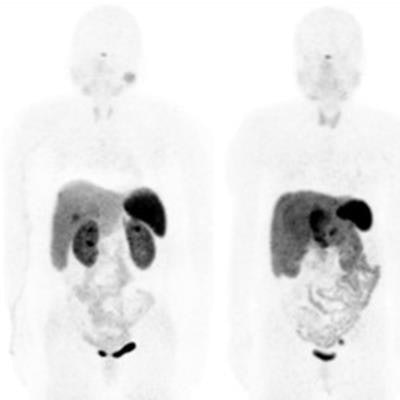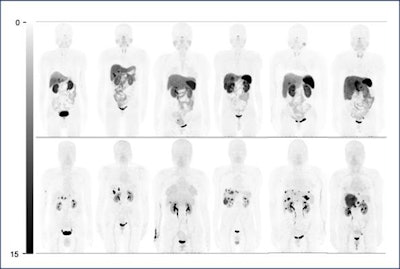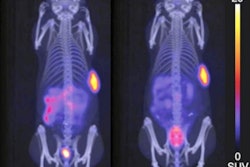
A new radiopharmaceutical has shown better imaging performance in tumor detection, staging, and restaging for neuroendocrine cancer patients with liver metastases than another imaging agent, according to research published in the June issue of the Journal of Nuclear Medicine.
Gallium-68 (Ga-68)-DOTA-JR11 performed better than another somatostatin receptor (SSTR) imaging agent, Ga-68 DOTATATE, in detecting liver metastases, with a better tumor-to-background ratio in a head-to-head comparison.
SSTRs are typically imaged using Ga-68-labeled peptides, which are agonists that bind to SSTRs to elicit a response. However, newly developed peptide antagonists that recognize and then block SSTRs have shown more favorable pharmacokinetics, better image contrast, higher tumor uptake, and better residence time in recent studies.
A prospective study led by Dr. Wenjia Zhu, nuclear medicine physician at Peking Union Medical College Hospital in Beijing, China, compared Ga-68-DOTATATE and Ga-68-DOTA-JR11 PET/CT in patients with metastatic, well-differentiated neuroendocrine tumors. They examined 31 patients on two consecutive days. Each patient received an intravenous injection of Ga-68-DOTATATE on the first day and Ga-68-DOTA-JR11 on the second day. Whole-body time-of-flight PET/CT scans were performed 40 to 60 minutes after each injection on the same scanner. Afterward, physiologic normal-organ uptake, lesion numbers, and lesion uptake were compared between the two agents.
 Comparison of whole-body maximum-intensity projections in six representative patients (patients 7, 8, 11, 14, 27, and 29 from left to right). Physiologic uptake is seen at pituitary gland, salivary glands, thyroids, adrenal glands, spleen (splenectomy in patients 7 and 8), and bowel on Ga‑68‑DOTATATE maximum-intensity projections (top). However, these normal organs show no uptake or very mild uptake on Ga-68-DOTA-JR11 maximum-intensity projections (bottom). In addition, Ga-68-DOTA-JR11 depicts more liver lesions than Ga-68-DOTATATE, with lower liver background. Image courtesy of the Journal of Nuclear Medicine.
Comparison of whole-body maximum-intensity projections in six representative patients (patients 7, 8, 11, 14, 27, and 29 from left to right). Physiologic uptake is seen at pituitary gland, salivary glands, thyroids, adrenal glands, spleen (splenectomy in patients 7 and 8), and bowel on Ga‑68‑DOTATATE maximum-intensity projections (top). However, these normal organs show no uptake or very mild uptake on Ga-68-DOTA-JR11 maximum-intensity projections (bottom). In addition, Ga-68-DOTA-JR11 depicts more liver lesions than Ga-68-DOTATATE, with lower liver background. Image courtesy of the Journal of Nuclear Medicine.The physiologic normal-organ uptake of the spleen, renal cortex, adrenal glands, pituitary glands, stomach wall, normal liver parenchyma, small intestine, pancreas, and bone marrow was significantly lower on Ga-68-DOTA-JR11 PET/CT than on Ga-68-DOTATATE PET/CT. The new radiotracer also detected significantly more liver lesions than Ga-68-DOTATATE. However, the older radiopharmaceutical detected more bone lesions than Ga-68-DOTA-JR11.
The radiopharmaceuticals showed similar lesion uptake for primary tumors and lymph node metastases on both patient-based and lesion-based comparisons, but the target-to-background ratio of liver lesions was significantly higher on Ga-68-DOTA-JR11, the researchers found.




















